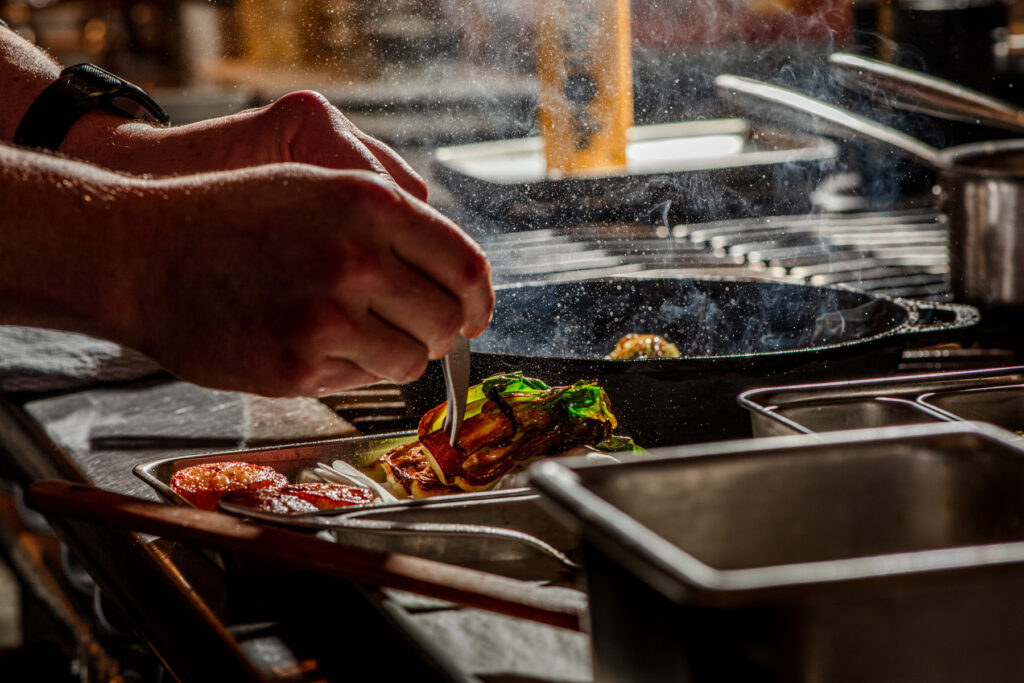
This Trending Cooking Oil Is Made with Algae—and It Might Just Replace Your Olive Oil
Chefs and home cooks are using this sustainable alternative, and you should be too.

Nicola Parisi
In a world where chartreuse squeeze bottles of EVOO and jars of fiery Chinese chili oil can have cult followings, it’s perhaps no surprise that the next trending ingredient could be an oil, too. But in this case, it’s one made not from olives or seeds, but a rather unexpected ingredient—algae. Strange though it may sound, algae oil is having a moment with chefs and home cooks alike. And the reasons are many.
“There are some distinct technical advantages to algae oil, in terms of neutrality of taste, high smoke point for cooking, and the feel-good notion of this oil having little to no impact on the environment in terms of its carbon footprint,” says chef Peter Hemsley of Aphotic, whose sustainability-focused San Francisco restaurant uses Alameda-based Spotlight oils in many of its dishes.

Nicola Parisi
Though algae oil might sound at first off-putting, the process of extraction is controlled and straightforward. Microalgae are grown in fermentation tanks where they’re fed sugar which they convert into a high oleic oil. It’s then expeller-pressed to extract the oil, bottled, and shipped off to your door. Popular brands like Spotlight and Los Angeles-based Algae Cooking Club say that this process is not only delicious, but better for the environment, too.

Courtesy of Algae Cooking Club
“By fermenting algae with plant sugars from rain-fed sugarcane, we create a process that produces high quantities of oil in just days, far faster than traditional crops,” says John Krzywicki, SVP, Commercial & Strategy at Spotlight. “This method not only conserves water and land but also minimizes stress on ecosystems and is infinitely scalable. And more specifically, algae oil has approximately 50% of the carbon footprint of avocado or canola oil and uses 80% less land to produce a cup of oil than sunflower or other common culinary oils.”
Beyond the environmental factors, algae oil is appealing to home cooks and chefs for its high smoke point, which allows it to handle high-heat cooking methods like frying and sautéing without breaking down, unlike some oils that can turn bitter at higher temperatures. Its stable emulsion properties make for sauces, dressings, and dips that won’t break. Plus it’s nearly completely neutral.

Nicola Parisi
“It’s basically an open canvas for whatever flavor you want to impart in your cooking,” says Hemsley.
The ways to use algae oil are endless. It can be drizzled into vinaigrettes, used as a coating oil for roasting vegetables, as a light frying oil for pan-searing steak and fish, or as a substitute for butter or vegetable oils when baking. We’ve also used it in tonnato and chimichurri. And its great for ingredients that need to brought to high heat quickly, like mushrooms or a fried egg.
Though it’s become common in the wellness world to see algae in supplements and smoothies at health food stores like Erewhon (it’s a plant-based source of omega-3s,) the team behind Algae Cooking Club believes that the cooking-oil category is where it really shines.

Nicola Parisi
“There has been an explosion in conversation around the bad fats found in seed oils. People have been seeking healthier, everyday cooking oils. Food curiosity is at an all-time high,” says Kasra Saidi, co-founder of Algae Cooking Club. “Food systems are failing, and olive oil prices have doubled in 12 months due to five straight years of draught in Spain. Algae cooking oil, on paper, answers all of these needs.”

Courtesy of Algae Cooking Club
Chefs are getting on board, too. Along with Aphotic’s partnership with Spotlight, the team at Eleven Madison Park collaborated with the Algae Oil Cooking Club for their recently-launched infused Gochugaru Chili Oil and Shiitake Mushroom Oil.
“We are all aware of the current state of our changing environment, and people are actively looking for better alternatives to the status quo,” says Hemsley. “It is a multi-faceted win.”
We only recommend things we love. If you buy something through our site, we might earn a commission.
